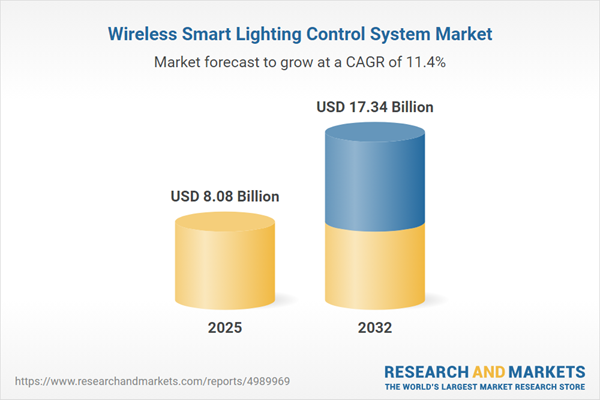Speak directly to the analyst to clarify any post sales queries you may have.
Wireless smart lighting control systems are swiftly reshaping how enterprises manage energy consumption, building connectivity, and lighting operations. By combining advanced sensors, wireless protocols, and analytics platforms, these solutions empower organizations to optimize illumination, support sustainability objectives, and streamline facility management across diverse use cases.
Market Snapshot
The Wireless Smart Lighting Control System Market grew from USD 7.28 billion in 2024 to USD 8.08 billion in 2025, continuing its upward trajectory with a CAGR of 11.44% and reaching USD 17.34 billion by 2032.
Senior leaders are leveraging market growth for operational efficiency and improved occupant experiences, with investment supported by growing adoption in commercial, infrastructure, and residential sectors. The expansion reflects evolving needs in real-time controls, seamless integration, and advanced data analytics aligned to sustainability and smart infrastructure trends.Scope & Segmentation
- Offerings: Hardware (controllers, drivers, gateways, sensors); Services (consulting, integration, installation, commissioning, maintenance, support); Software (analytics, management platforms)
- Communication Technologies: Bluetooth, RF, Wi-Fi, ZigBee
- Installations: New installations, retrofits
- Applications: Indoor, outdoor
- End Uses: Commercial (education, healthcare, hospitality, offices, retail); Industrial (logistics, manufacturing, oil and gas, pharmaceuticals); Infrastructure (public spaces, street lighting); Residential
- Sales Channels: Offline sales, online sales (company websites, e-commerce platforms)
- Regional Coverage: Americas (North America, Latin America), Europe, Middle East & Africa (Europe, Middle East, Africa), Asia-Pacific (China, India, Japan, Australia, South Korea, Indonesia, Thailand, Malaysia, Singapore, Taiwan)
- Companies Analyzed: Acuity Brands, Casambi Technologies, Cisco, Deako, Honeywell, Ideal Industries, Infineon Technologies, Itron, Johnson Controls, Koninklijke Philips, Legrand, Lutron Electronics, Murata Manufacturing, Panasonic Holdings, Savant Systems, Schneider Electric, Siemens, Synapse Wireless, Texas Instruments, TVILIGHT Projects, Venture Lighting, Dialight, Leviton Manufacturing
Key Takeaways
- Wireless smart lighting control systems transcend legacy infrastructure by supporting adaptive, real-time illumination management, making them integral to smart building and city initiatives.
- Technological innovations such as edge computing, machine learning, and digital twins are enabling advanced use cases including predictive maintenance, asset tracking, and context-aware lighting scenarios.
- Stakeholder collaboration on open standards and interoperability is addressing integration and fragmentation challenges, boosting user adoption across complex multi-vendor environments.
- Diverse protocols and architectures support both full-scale new builds and cost-efficient retrofits, extending market potential from high-density campuses to urban infrastructure and existing properties.
- Customer demands vary by vertical: commercial and industrial users seek operational resilience, while residential and infrastructure adopters prioritize ease of use, system reliability, and quality assurance.
- Global and regional players are differentiating through partnerships, modular product designs, and targeted service offerings, fostering ecosystem development and direct alignment with emerging market needs.
Tariff Impact
Beginning in 2025, new United States tariffs on electronic components are creating cost pressures through increased duties on controllers, sensors, and communication hardware. Stakeholders are balancing supply chain resilience with localization, exploring alternative sourcing, reengineering designs, and engaging policymakers to navigate these regulatory shifts. Such dynamics intensify the focus on innovative procurement, streamlined architectures, and trade-compliant production strategies.
Methodology & Data Sources
This report blends extensive secondary research with direct interviews of senior executives, systems integrators, and facility managers. Insights are validated through iterative workshops and proprietary scoring frameworks, ensuring comprehensive, unbiased market perspectives and actionable intelligence for decision-makers.
Why This Report Matters
- Enables leaders to benchmark competitors and identify partnership opportunities across the wireless smart lighting control sector.
- Supports strategic planning for new investments, regional market entry, or technology upgrades by revealing regulatory, supply chain, and segmentation insights.
- Equips product and operations executives with clarity on evolving standards, channel strategies, and end-user demands.
Conclusion
Wireless smart lighting control systems are set to drive the evolution of digital infrastructure across industries and geographies. Executives relying on actionable, validated insights will be best equipped for sustainable growth and competitive differentiation.
Additional Product Information:
- Purchase of this report includes 1 year online access with quarterly updates.
- This report can be updated on request. Please contact our Customer Experience team using the Ask a Question widget on our website.
Table of Contents
3. Executive Summary
4. Market Overview
7. Cumulative Impact of Artificial Intelligence 2025
Companies Mentioned
The companies profiled in this Wireless Smart Lighting Control System market report include:- Acuity Brands, Inc.
- Casambi Technologies Oy / Inc.
- Cisco Systems, Inc.
- Deako, Inc.
- Honeywell International Inc.
- Ideal Industries, Inc.
- Infineon Technologies AG
- Itron, Inc.
- Johnson Controls International plc
- Koninklijke Philips N.V.
- Legrand S.A.
- Lutron Electronics Co., Inc.
- Murata Manufacturing Co., Ltd.
- Panasonic Holdings Corporation
- Savant Systems, Inc.
- Schneider Electric SE
- Siemens AG
- Synapse Wireless, Inc.
- Texas Instruments Incorporated
- TVILIGHT Projects B.V.
- Venture Lighting International
- Dialight PLC
- Leviton Manufacturing Company, Inc.
Table Information
| Report Attribute | Details |
|---|---|
| No. of Pages | 190 |
| Published | November 2025 |
| Forecast Period | 2025 - 2032 |
| Estimated Market Value ( USD | $ 8.08 Billion |
| Forecasted Market Value ( USD | $ 17.34 Billion |
| Compound Annual Growth Rate | 11.4% |
| Regions Covered | Global |
| No. of Companies Mentioned | 24 |









